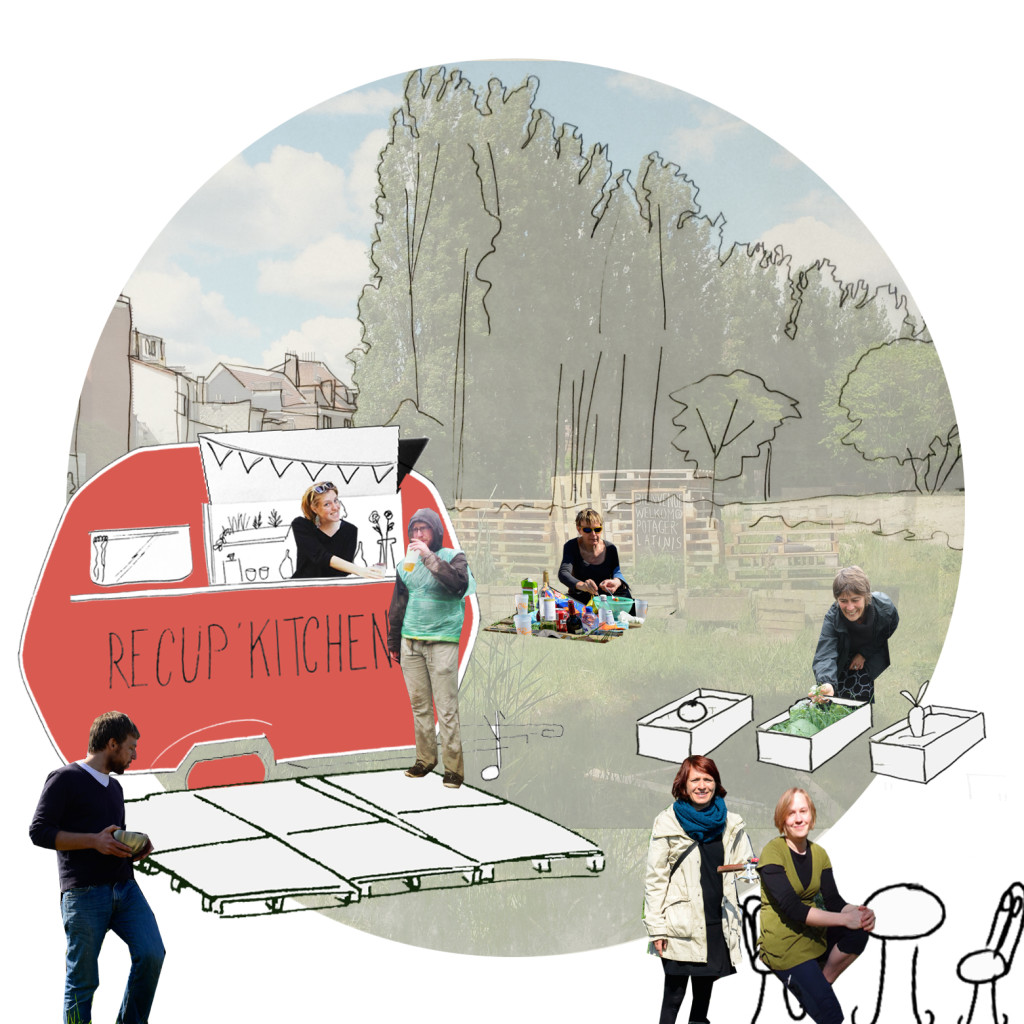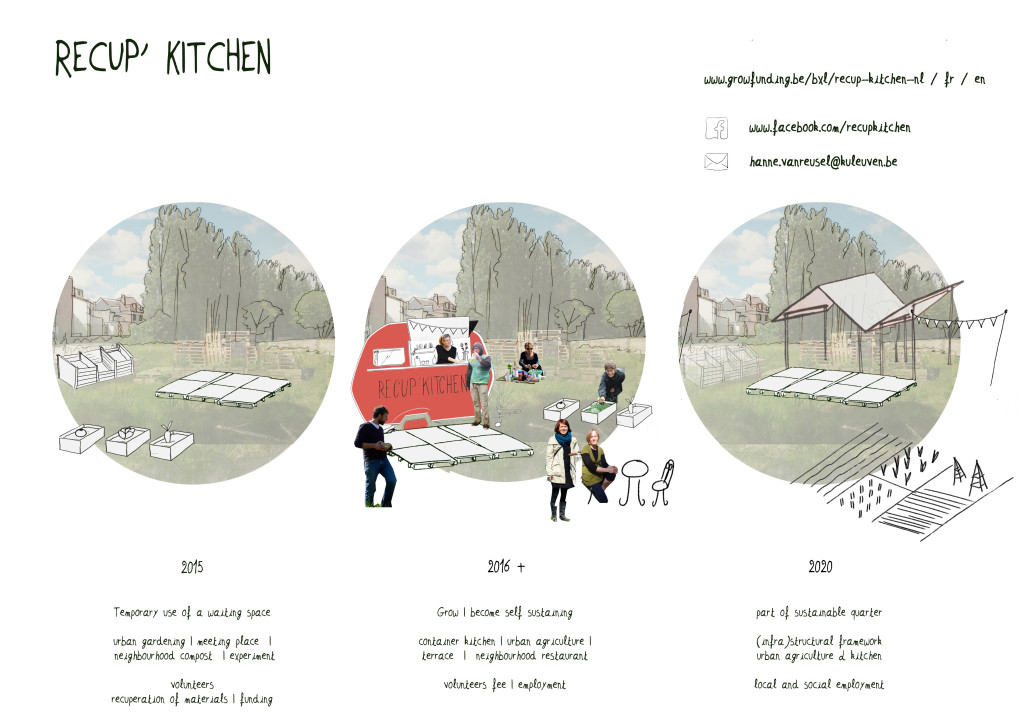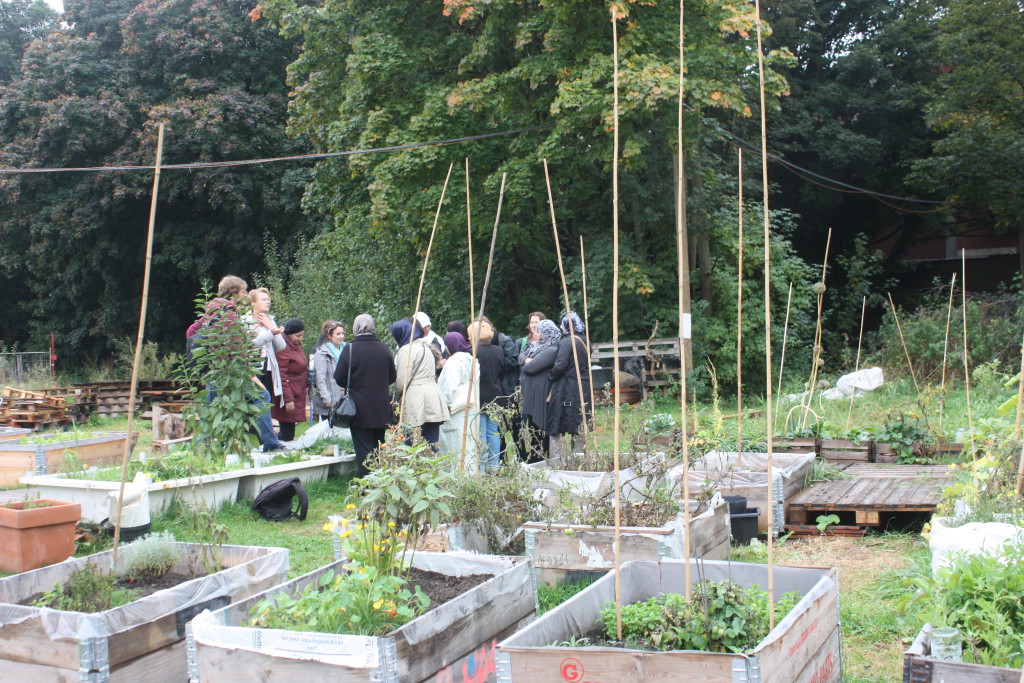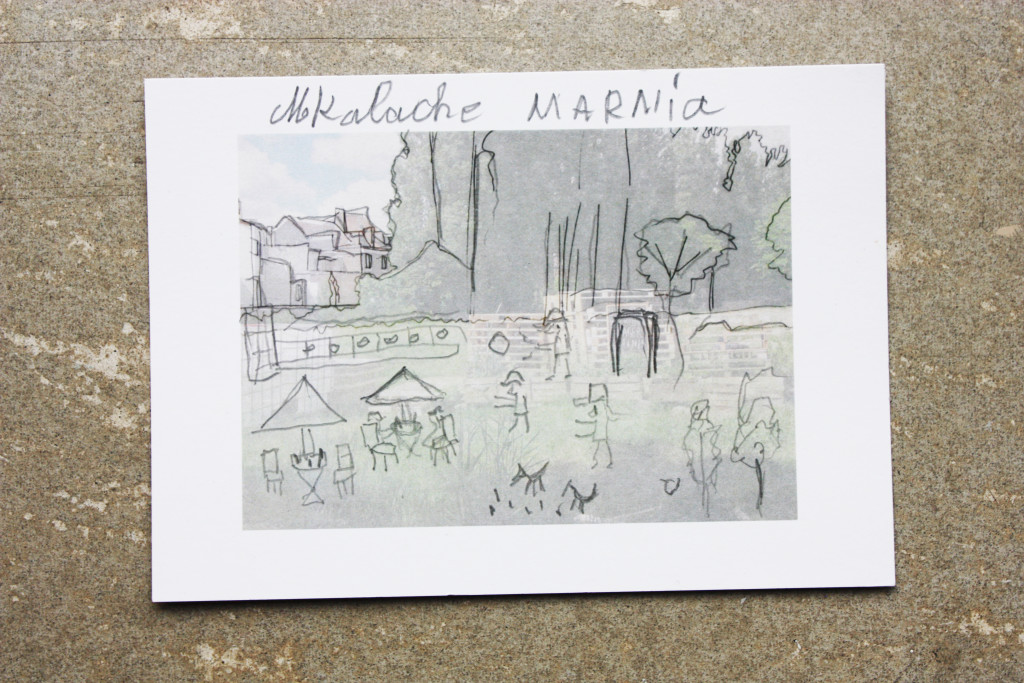RECUP’KITCHEN, co-design of temporary use for performative urbanism
The Josaphat site in Schaerbeek (Brussels) is an open space of 25ha. The planning process to transform this ‘vacant land into a ‘sustainable and mixed neighbourhood’ starts from a blank page. Though, today this wasteland hosts a rich biodiversity and is the subject of varying citizen initiatives that illustrate the need for more participation in making city.
Locals and diverse Brussels associations[1] highlight the use value of the Josaphat site. With their improvised constructions and creative appropriations, they (un)consciously load this public land with identity, (hi)story and relational values. A tangible and small-scale place-making takes place on-site.
In parallel, a both strongly related and yet often disconnected process of visioning is emerging. An autonomous citizen collective[2] critically reflects on the way our cities are being shaped and plea for more participation in the design, construction and governance of urban space. The Josaphat site is envisioned as a field of opportunity for a critical alternative.
Both processes aim to design and govern the city in a more inclusive and resilient manner. However, a more strongly intertwined civic driven process of place-making and visioning seems to be desired to unfold a performative urbanism. In this way an alternative pathway for city-making can be manifested –imagined, explored and constructed- in the urban realm.
In order to further bridge the explicitly articulated values of the collective vision with the more spontaneous and tangible actions on-site, a more considered collective design process has been taking off. The RECUP’KITCHEN concept has been serendipitously unfolding throughout the on-site temporary use –emerging from concrete needs- and overtly embraces the ideology, formulated in the visioning process.
At this moment a crowdfunding campaign has been set up, explicitly chosen to maintain autonomy and expand the participation of citizens, as well as to further enlarge the debate on the values citizens aim to inscribe in the socio-spatial development of the city. The idea for a mobile kitchen prioritises food recuperation, reuse of (waste)materials, auto construction, self-governance, transparency, social economy, connecting and sharing. Already the collective articulation of an applied vision in a concrete and local design -even still open and not realised- manifests the need for a more emancipated and ‘care-taking’ way of city making.
More info about RECUP’KITCHEN and support: https://www.growfunding.be/bxl/recup-kitchen-en
[1] Dewey asbl, Jardin Latinis, Commons Josaphat, collectif BAYA, Common Grounds, BXL.WildlifeFestival, naturalists, etcetera …
[2] Commons Josaphat








Thanks for sharing this project Hanne! I am personally very intrigued by the concept of ‘performative urbanism’ and the need to ‘unfold it’. Could you perhaps elaborate on this? How is this an ‘alternative pathway’ for city making?
Nice you picked up these concepts. They are very loose notions that entail different readings, which allows me to still fully explore them myself. I hope my perspective, through the experiences at the Josaphat site, can also contribute to the discussion and inspire more designers and citizens.
“a collective garden, never is just a garden ” (1)
When I started to explore Brussels, I was pleasantly surprised by the rich amount of self-organized initiatives (re)appropriating the city. From an architectural perspective it is inspiring to reflect on what these initiatives tell about our public spaces and our city. What are citizens missing or what do they want to change so eagerly that they invest their energy, talents and time in these diverse uses and what can we learn from it? I am especially intrigued by the various values that are spatially represented through these initiatives and how they hope to build on an other –more resilient- way of living together in the public urban realm.
“Manifesting desire into reality is performance, and nowadays it is one of the most powerful tools people have with which to achieve their goals.” (2)
Gadanho(3) refers to the legacy of performance art and its crucial contribution to render the political dimension of the street visible. Inspired by this movement, also urban actions can bring on a framework to acquire political meaning, through their concrete spatial action and articulation of concerns. Going ‘streetwise’ and collectively imagining, exploring and constructing an envisioned alternative as such, also forms part of an on-going debate on what kind of city we aspire.
I like the notion of the ‘performative’ as it not only values the actual performance of a small scaled and self organised alternative, but it also highlights the importance of the explicit articulation of the underlying values.
In practice this twofold is not always as explicitly present; the long term and large scale perspective is often poorly represented in the approach of self-organized initiatives. However, nearly always you can read these concerns at the (fundamental) background of the actions, like during internal discussions or when collectively writing an application for funding. I associate ‘unfolding’ with the efflorescence of a flower. A performance that is showing off its force and beauty, but essentially starts from what is already there. It takes a lot of care and energy to grow out to this moment.
I am convinced that if the underlying visioning and actual place-making are more fiercely entangled, this would not only empower these kind of urban appropriations, but simultaneously can bring on a more rich debate about our city.
This is an on-going travel, lying out a pathway that -as a political performance- can help us to find/ fund a more open way to further develop our city, that can more swiftly respond to our needs and the alternative future that we collectively envisio.
Would you call your interventions performative?
————————-
1 Mathieu of Dewey asbl, one of the leading actors behind the collective garden and RECUP’KITCHEN and highly involved in Schaerbeek’s local community life.
2 Herrero Delicado, G., & José Marcos, M. (2011, 12 20). Performing architecture. An historic convergence of artists, curators, architects and critics explore the limits of their practices through a series of performative interventions. Domus. Opgehaald van http://www.domusweb.it/en/architecture/2011/12/20/performing-architecture.html
3 Gadanho, P. (2011, 09 21). Back to the Streets: The Rise of Performance Architecture. Domus. Opgehaald van http://www.domusweb.it/en/op-ed/2011/09/21/back-to-the-streets-the-rise-of-performance-architecture.html
Yes, well let’s say that I try to make my ‘interventions’ performative in several ways. I like to embed values of ‘performance’ (from art) in them, but I also see the value and definitely see them from the perspective of performance that you outline.
In fact, one of the ‘definitions’ of (prefigurative) interventions that I work with (from Andrew Boyd) I see very close to what you refer as the notion of ‘performative’: “Prefigurative interventions are direct actions sited at the point of assumption — where beliefs are made and unmade, and the limits of the possible can be stretched. The goal of a prefigurative intervention is twofold: to offer a compelling glimpse of a possible, and better, future, and also — slyly or baldly — to point up the poverty of imagination of the world we actually do live in.”
I am also curious how the mobile kitchen has come to be (as an idea, a proposal) and how do you envision will be activated?
Ha, I thought it would not take long to give a reply, but it turned out a good exercise in clearly representing a loose, multi-layered and very dynamic process.
The idea evolved rather spontaneously through everyday discussions, loose brainstorms, concrete on-site needs and brings on a representation of the desired values that underpin the project.
I believe it is crucial ideas for temporary use can travel around; fade away when not opportune, wander around in inspired minds and pop up again in different constellations. I would describe the design process of the RECUP’KITCHEN concept in the same way, travelling.
Its design as it is now is part of a serendipitous process, starting from the loose idea for a ‘cabine de défrichage’ imagined to centralize different dynamics of temporary use while being a central place for debate. When it got picked up by the actors behind the collective garden and monthly picnics, the main idea got rearticulated into a more concrete proposal that meets on-site needs.
The temporary kitchen concept got embraced quickly and its design is still part of an on-going process. In various everyday discussions, organized meetings and loose brainstorms, RECUP’KITCHEN is continuously questioned and rethought to respond to the various desires and expectations. Though, the collectively agreed vision and underpinned values are relatively fixed.
I believe the description of the project I gave above gives a very personal reading of what RECUPKITCHEN entails. As urban designer I am, like all the other involved actors, continuously appropriating and rethinking the main idea from my point of view, aspiring to contribute with my knowledge, skills and desires.
We hope to continue in this travelling sphere; it is for this reason we chose to use a simple and open sketch to illustrate our idea.